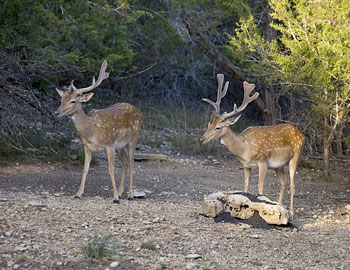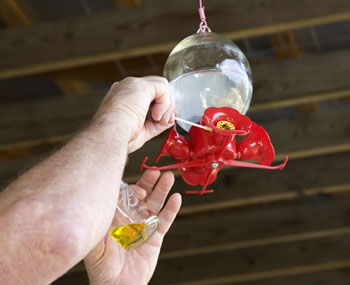Archive for 'Food' Category
2/10-inch rain
Two male Fallow deer waiting at deer feeding area, very tame and with broken horns.

Caretaker's note: These 2 Fallow deer passed through to feed at the White-tailed deer feeding station. They are very tame and let us get close enough to almost feed a carrot by hand. Based on one's broken horn, it seems they are aggressive with one another . They were also very aggressive towards the native deer and chased them away from the feeding station. They did not stay long and must have moved on.
- Hummingbird feeders all empty after 4 days
- Dung beetles cleaning up deer droppings
Posted in
2008 Journal, Census, Food
Caretaker's note: 2008 is a year of extreme to exceptional drought in Central Texas. Supplemental watering helps to keep last years new plantings alive. All new plantings are native species that are selected to be drought tolerant, but it does take a few years for new plants to become established to withstand harsh drought conditions. There were no new plantings this year due to the drought. To conserve water, it is advised to water early in the morning or late in the day.
Posted in
2008 Journal, Census, Habitat, Food, Water
Very dry and windy. Used the water mister for birds.
- 8am, saw Wild turkey in driveway walking to water guzzler
- Refreshed all hummingbird feeders and used olive oil on the yellow feeding ports to deter bees
- Saw anoles mating, green male and brown female
- Saw a lizard leap and grab a brown and gray mottled moth, it spit it out and the moth flew away.
Posted in
2008 Journal, Census, Food, Water
Very dry, wildflowers are small and sparse. Few insects seen.
Caretaker's note: A Jackrabbit is actually a hare and not a rabbit. It is larger than a rabbit and they typically have taller hind legs and longer ears.
- Removed Johnson grass and Beggars lice weed from the yard
- Removed junipers that are growing up too close underneath the oaks
Posted in
2008 Journal, Census, Habitat, Food
30th

Caretaker's note: Due to colony collapse disorder (CCD), bee populations are declining nationwide. watersto_jennystone caretakers are glad to see healthy populations of bees on the land. However, their competition with hummingbirds over the sugar water in the hummingbird feeders has caused concern for the hummingbirds. The bees are attracted to the color yellow. To deter bees from taking over the feeders, caretakers swab a bit of olive oil on the yellow feeding ports of the hummingbird feeder.
Posted in
2008 Journal, Census, Predator, Food
<< Previous Entries


